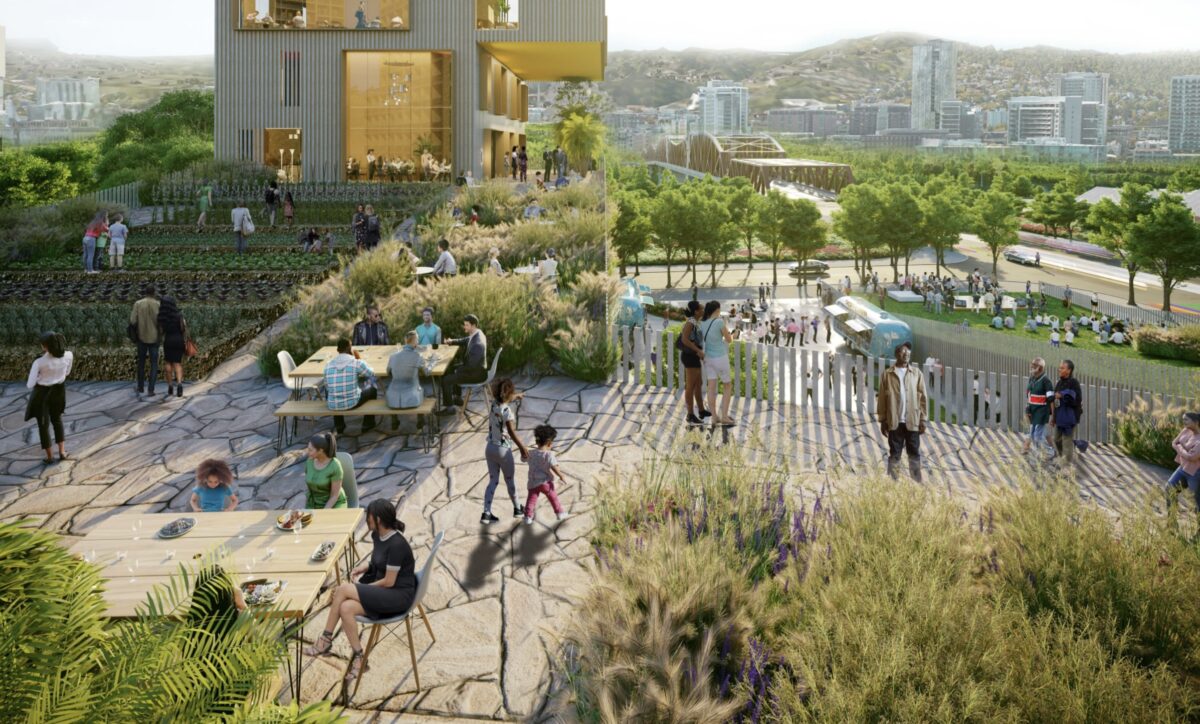
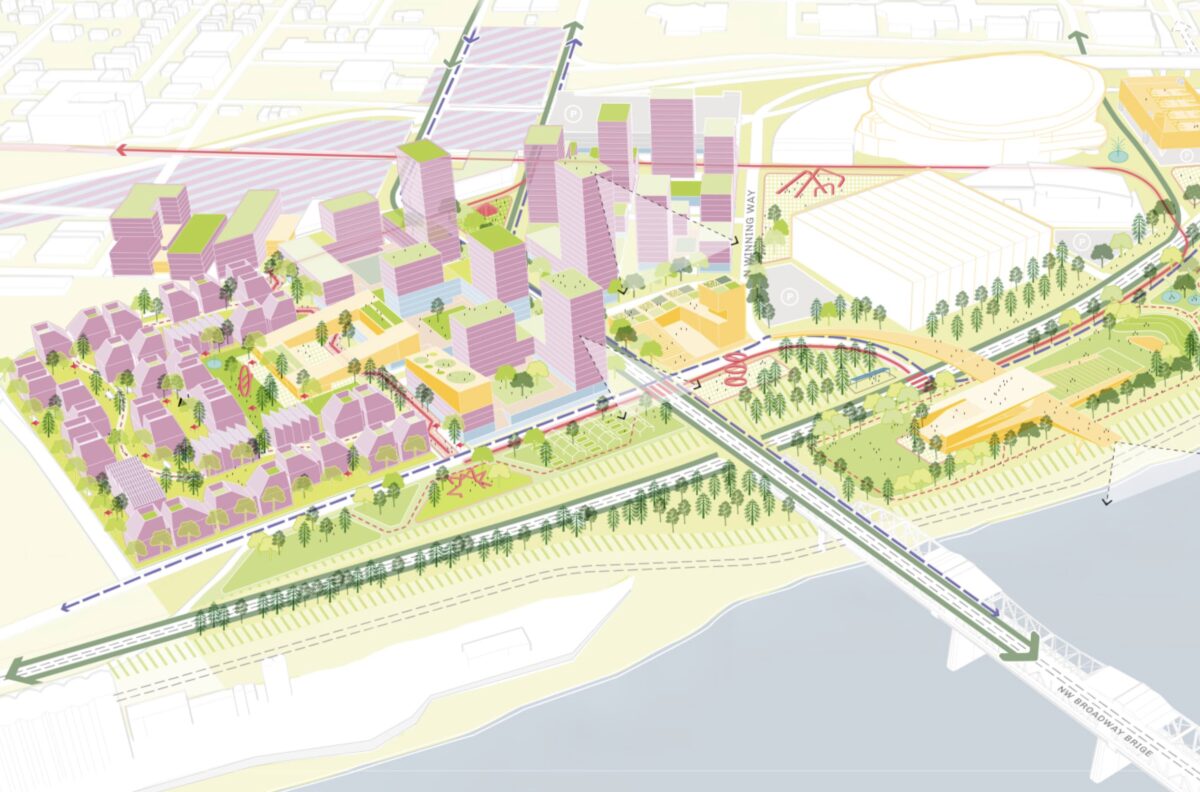
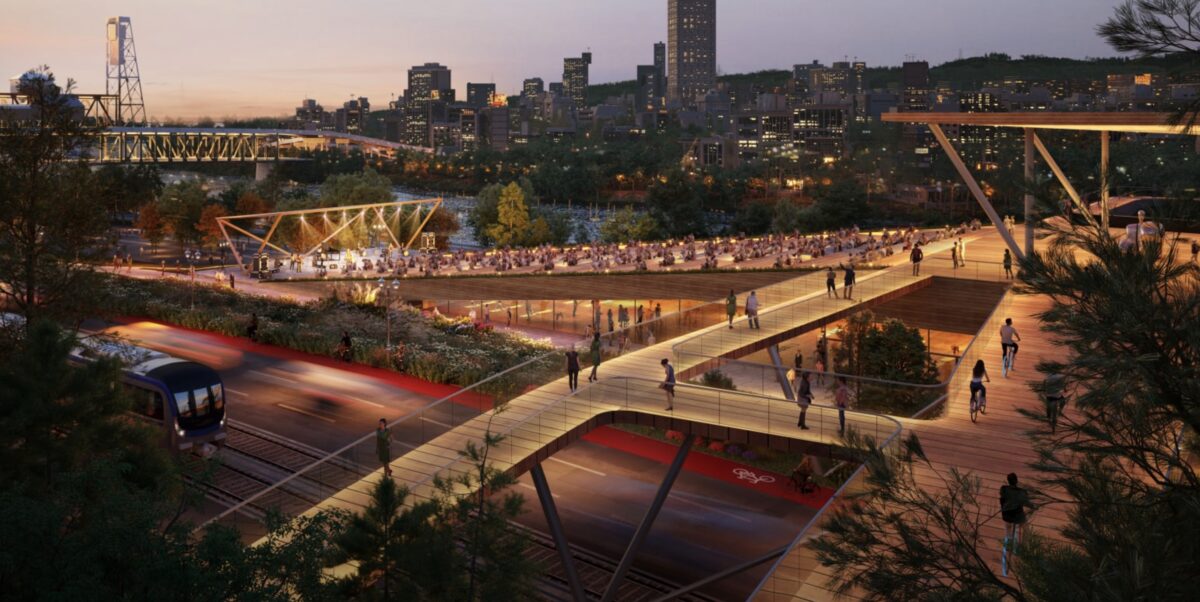
The Reconnecting Communities Pilot Program (RCPP) was established in President Biden’s Infrastructure Investments and Jobs Act back in 2021, and Portlanders have had their eyes on it from the start. This program acknowledges the damage some transportation infrastructure — especially freeway projects like I-5 in Portland — has created in communities due to displacement and other negative impacts, and it sets aside $1 billion in federal funds over five years to help make things right.
One of the first beneficiaries of this program will be Portland’s own Albina Vision Trust (AVT), who were recently awarded an $800,000 RCPP planning grant. AVT launched their project (on a bike ride!) in 2017 and has since become a major player in conversations about the Rose Quarter. In June 2021 they inked their first of what is likely to be many real estate development deals.
AVT applied for this grant last fall in partnership with the Portland Bureau of Transportation, and will use it to make initial plans for what the Rose Quarter and Lower Albina areas will look like when/if the Oregon Department of Transportation adds a highway cover to I-5 in the district. ODOT also tapped the RCPP for a very substantial grant of $100 million to construct the I-5 highway covers as part of their Rose Quarter freeway project. But ODOT’s application was denied funding in this cycle.
Other than the starkly different amounts of money requested, AVT/PBOT and ODOT’s applications may seem similar because they both deal with capping I-5 at the Rose Quarter. But while ODOT’s proposal to add covers to I-5 is wrapped up in their highly-controversial freeway expansion plan, the $800,000 in federal funds allocated to AVT and PBOT are not necessarily contingent on a freeway expansion.
Albina neighborhood advocates with AVT have signed onto ODOT’s Rose Quarter plan because they know it may be their best bet to negotiate capping the freeway to reconnect the neighborhood that was so negatively affected by the construction of I-5 in the 1960s. ODOT, meanwhile, knows that including these expensive freeway covers in the I-5 expansion project is the only way they get any federal funding for the plan. But so far, ODOT has been having a difficult time securing that funding even with the Albina neighborhood restoration as part of their pitch.
From the time the RCPP was first announced, some transportation advocates have been concerned that state DOTs would apply for RCPP money under the guise of restorative justice for neighborhoods harmed by infrastructure projects and then use the funding for freeway expansions. A blog post from transportation nonprofit America Walks calls ODOT out for this specifically, saying the proposed cap over I-5 at the Rose Quarter “has the potential to be a positive investment for Portland’s historically Black Albina neighborhood” but the USDOT should deny their application because it “comes attached to an expansion of the highway that will increase environmental and economic damage along the corridor.”
“We’re calling on USDOT to reject proposals like these, as they fail to align with the goals of the Reconnecting Communities program. Proposals like these leave in place the structures that cause damage — or even worse, expand them,” the post continues. “For that reason, they address neither environmental justice nor equitable development and result in either a negligible increase in community connectivity or a net decrease, in the case of proposals that bundle highway expansions into the project.”
Perhaps the U.S. Department of Transportation heard these concerns in their first round of RCPP funding — or maybe they just didn’t want to give ODOT more than half of the $185 million they have allocated for the program in its first year.
There’s still a lot up in the air about this project. It’s unclear how AVT and PBOT might be able to work independently of ODOT to make plans for a future Albina neighborhood that isn’t disconnected by I-5, and there will be more opportunities in the future for ODOT to apply for RCPP funding. But for now, critics of the Rose Quarter expansion project are calling this a win.


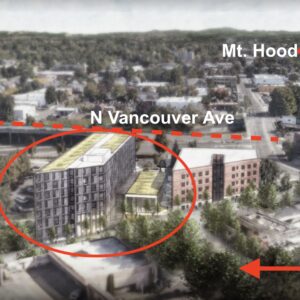


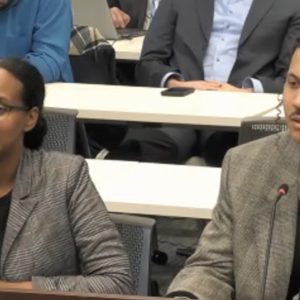
Thanks for reading.
BikePortland has served this community with independent community journalism since 2005. We rely on subscriptions from readers like you to survive. Your financial support is vital in keeping this valuable resource alive and well.
Please subscribe today to strengthen and expand our work.
Yay!
Just to be reiterate, as writers tend to move magnitudes around by spelling out low dollars, and shortening large dollars (which confuses readers).
$100 million grant to actually build something was not approved.
$0.8 million grant to do some paperwork was approved.
Or:
$100,000,000 grant : denied
$800,000 grant : approved
This is part of the highway builders plan: take advantage of our mental inability to understand the huge numbers involved.
The take-away here is an effort to equity-wash the project is succeeding, as long as tiny grants (in the transportation world) that don’t build anything get headlines.
Super awesome, great job AVT.
Someone get the memo to ODOT: it’s been a decade now and they haven’t gotten approval or funding for anything at the RQ. Probably an upwards $10 million in consulting fees and wasted tax dollars, based on my past FOIA funding request. You think Lee Beyers from Eugene now on the OTC is going to deliver anything in Portland after a decade on the top Oregon Joint Transport Committee? Someone needs to retire already. This isn’t a retirement hobby this is our home.
It’s clear no matter the presidency; (Republicans or Democrats) ODOT has not been able to deliver anything but constant community head aches.
Wow that looks like a great project, I’m surprised I haven’t heard more about it. Seems like too little money, but I hope they succeed at making this. That plus the OMSI development would do a lot to make east Portland into a more inviting place for people not inside tons of steel.
Be nice if we could get some funds to
reconnect other communities that were also impacted by the interstate system (I -205, I-84). Albina wasn’t the only community negatively impacted.
I-84 had pretty minimal community impact, especially relative to a typical urban freeway owing to being located either in a gulch, on mostly undeveloped land, or abutting a busy railroad/industrial area. I-205 certainly did have negative impacts to the communities nearby, but didn’t have as big an impact owing to being built in a less intensely developed area (relative to I-5 and I-405). I-405 on the other hand was ran through close to the densest part of the city and certainly had major impacts that should be a major regional focus. I’d say it should be removed altogether.
Other non-interstate highway projects also have had sometimes just as large of impacts. The Ross Island Bridge did some major damage to Lair Hill/Corbett, along with Brooklyn. Most of the most dangerous roads in the city (Powell, 82nd, Sandy) are all current or former ODOT highways widened to allow for more automobile traffic that now act as community barriers.
Albina is the community that gets the most interest because of the racial history, and the relative recency of it all. I-5 was built in the 50s and 60s – still within living memory. And the impacts are more acute in North Portland – try crossing I-5 at Lombard on foot. Considering the pittance of funds being given out for the “reconnecting communities” program it’s not surprising (or bad) that the focus is on Albina – but more money is desperately needed.
COTW
The 405 would probably be easier to cap, and if we aren’t shunting all traffic onto the 205, I’d rather cap the 405 and remove the 5 from the Rose Quarter to Lair Hill. Remove the downtown entrances/exits from the 405 and cap as much of the remaining 5 and 205 as possible.
The working-class immigrant area around the southern end of 405 was so totally wiped out by the freeway and urban renewal that there is no longer any trace of their presence. And 405 is a barrier to all points south.
That area would be relatively easy to cap, and logical too, it would probably have a good ROI. 405, in general, disrupts the downtown street grid with its numerous on- and off-ramps.
Vera Katz had a plan for capping the whole thing, but the idea gets overlooked in present day discussions.
Yeah, I-405 is a more natural focus for capping I think. It’s the densest part of the city and doesn’t suffer as much from ostentatiously auto focused development. There’s something like 150 parkings lots and garages within a half mile of the RQ project area. I’ll be happy to see freeway caps, but I think they are much worse than freeway removal. The cars that freeways bring often are often just as destructive as the roads themselves.
You’re kidding right? Have you ever tried to get from Laurelhurst to Hollywood? I-84 is a HUGE obstacle for walking and biking all along its route. Let’s try not to minimize it.
Of course. It’s just that barrier (Sullivan’s gulch) predates I-84. I’m not minimizing the barrier, just pointing out that it’s not a sole result of a freeway. It was a barrier when the Oregon Railway & Navigation Company built their mainline through in the 1870s and it was a barrier when ODOT built the Banfield Freeway in the 1950s. And it would have been a barrier even if those projects never happened.
I-5 wasn’t a barrier until it was built in the mid 1960s. Communities were torn in half, and it was directly responsible for lots of economic hardship, particularly for businesses on Mississippi Ave and N Williams – 2 of the 3 leading businesses districts for Black Portlanders in the era. There is no “reconnecting” to be done between Laurelhurst and Hollywood since they have only ever been nominally connected.
Should the bridge over I-84 on Sandy be improved for cycling and walking? Yes! 100%! But this is about a federal grant program to undo harms of a prior era of destructive highway building – typically in poorer, Blacker areas of cities (which is something Laurelhust explicitly forbid until sometime in the 1970s).
An infill MAX station at NE 32nd, with pedestrian overpasses to both the north and south would be a huge improvement for this area.
The North/South crossing options also get very bad east of NE 60th. Overpasses are few and far between, and the ones that do exist are extremely pedestrian/bike hostile.
I think 28th is a more natural location for a MAX infill station personally – since it’s closer to halfway between 42nd and 11th, and already has an existing bridge (unless you mean 33rd instead of 32nd?). Basically all the bridges over 84/Sullivan’s Gulch need some better ped/bike accommodations, but the ones on Halsey really come to mind as being exceptionally bad. I wish PBOT would actually do anything at all to fix some of the dangerous spots in the city
While I-84 absolutely is a toxic sewer that should be dealt with, it’s important to remember the history of the gulch. The topography and the railroad were already a barrier:
https://alamedahistory.org/2021/11/12/sullivans-gulch-chapter-2-manufacturing-comes-to-the-gulch/
Of course, railroads are much easier to cross, and there could be an alternate history here where we go all-in on public transit and Sullivan’s gulch is a 4-track high-speed rail/commuter rail corridor. It would still be a huge barrier in that case.
Portland pushed people of color out of the area long ago and then threw salt on the wounds by gentrifying it even further. If you want to help BIPOCs the money should be invested on the east side of Portland.
It wasn’t like people were forcibly removed. Trying to think you can somehow prevent market forces is folly.
I mean you certainly can prevent market forces – it’s called regulation. Market forces unattended caused things like the Cuyahoga River literally burning in the 60s and 70s from industrial pollution. Preventing market forces is good in tons of situations, and housing is no different.
Lo-key racism right here, Laura Shirozako. BIPOC people were forced to live in Vanport, then were forced to move to redlined areas of Portland, then were forced to move so the convention center could be built, then forced to move so I-5 could be built, and 29 blocks of people forced to move so emmanual legacy hospital could be built (Including the blocks that have not had anything built on them since peoples homes/ markets/ churches were demolished.) Home ownership was denied for generations from people, because of the color of their skin, limiting generational wealth passed down. Also, Porlanders of Japanese decent were forced into internment camps and their homes taken from them by the city…
And then you come in here telling BIPOC folks that they and their families were not forcibly removed. What do you mean by that statement, exactly?
Those kids who were redlined, evicted, displaced, and then faced life-changing discrimination by landlords/banks should have picked a better family to be born into.
According to some folks, these events never took place, and “It wasn’t like people were forcibly removed.” History erased.
“The Color of Law” is a fairly complete history of explicitly racist land use planning by public and private agencies in the United States.
Ah the classic Portland response, calling someone racist when they see something differently. I agree with Laura, “reparations via freeway caps” and/or trying to recreate some nostalgic Utopian neighborhood of the past is doomed to failure. Many races and classes were harmed by the interstate system. Should we try to atone for past wrongs? Of course. But why is all the focus on a small subset of peoples? It’s time to move forward not backwards.
But BIPOC people were forced to move. Moved to internment camps, moved to redlined districts, moved so that the convention center could be built, moved to Emmanual legacy hospital could get built, moved so I-5 could get built. Moved to Woodlawn Park could get built.
My understanding is that plenty of non BIPOC people (far more, in fact) were also been displaced by highway construction and urban renewal. Many also moved to redlined districts, then had to move out of the way as we built more. Many also suffered from generational poverty.
It’s not productive to compare one family’s suffering to another. It pretty much all sucks if you’re on the receiving end.
I’d say that’s slightly flawed – but depends on your definition of BIPOC I guess. Typical earlier verbiage in redlining and restrictive covenants is something like “subversive races”, which typically meant something more like “not white Anglo Protestant”. But as is typical in American history, Black people bore the brunt of it – especially in the later part of the redlining era.
And while it’s probably true that by numbers, more white Americans were displaced by highway building projects and urban renewal that’s a bit beside the point. Planners specifically routed highways through redlined areas because it was cheaper – but those were also the only places Black Americans were allowed to live. So they bore a disproportionate burden. And the highway projects all benefited suburban commuters – who were pearly white by a combination of virulent racism and FHA policy.
Urban renewal and highway building negatively affected almost every single Black community in every large city in the entire country. This is just not true for any other group of people. They bore a disproportionate burden – and deserve just compensation for what was taken from them (land, economic opportunity, generational wealth) by the Federal Government.
Given our modern perspective, I will not defend urban renewal or it’s more recent manifestations*, and I agree that everyone whose property was taken deserved just compensation. It’s literally their constitutional right.
I’ve seen no evidence that anyone got shortchanged. Have you? If people were not fairly compensated, I would support redress to those who were underpaid.
Otherwise, we’re just rehashing a broadly popular policy decision made 80+ years ago in a very different social, economic, technical, and environmental milieu.
*Those of you who wish PBOT would shortcut public consultation and “just do the right thing”, these are the sort of outcomes you can get. I’m sure urban freeways seemed like the right thing at the time to planners, DOT officials, and the public at large.
Sorry… 60+ years.
There is a figurative mountain of evidence chronicling how urban renewal and freeway building projects used less than savory means to acquire property. On the freeway side in Portland, ODOT paid less than $50 for some homes and built no replacement housing because they judged there to be sufficient vacant stock in the region. Even at 1950s prices, $50 for a home doesn’t even come close to the market value – and this isn’t even getting into the second order costs, like land-value reductions for adjacent property owners.
The destruction of the urban fabric of primarily lower-income sections of cities (often after being dubiously labeled as “blighted” to get federal $) had impacts much further reaching than property values for homeowners. Renters were typically offered no compensation at all, and given that this almost all took place during an era where the FHA explicitly forbid government backed mortgages to Black Americans this (again) had a hugely negative impact on the already heavily marginalized Black communities.
I’m a renter, and if the City of Portland were to condemn the building I live in while offering no compensation to me, I’d be out several thousand dollars to get a truck, move all my stuff, find another place to live, put down a security deposit, etc. This is a cost I could afford right now, but there have been times in my life when I would not have been able to – and that cost can be prohibitive (and likely was) for wide swaths of affected people.
If you’re interested in constitutional arguments concerning things like this, The Color of Law and Sundown Towns are excellent books concerning redlining and racism in housing and urban renewal.
I’m no urban renewal apologist. I think that demolishing the fabric of communities is very socially damaging, and I wish we had learned more from the mistakes of that era.
That article provides no information about the market value of a house that ODOT bought for $50. We don’t even know if the owner thought that was an unfair price.
I’m open to the possibility that people were not appropriately compensated, but I still haven’t seen evidence that they were. What you seem to be saying is that more generally it sucked for everyone, so people must have been underpaid. If there is some accounting still due, someone is going to have to get a lot more specific than that. But not me — though my grandparents were relocated as part of one of these projects, I’ve moved on. At some point you just need to move forward with what you’ve got.
I think we agree that people should have been paid what their property was worth, and I have no problems with people making a claim if they weren’t. I think we would also agree that if we were remaking the decisions of the late 1950s in today’s setting, we might make different choices.
“We don’t know if the owner thought it was a fair price”. No one in their right mind would think $50 for any substantial parcel of land in a city is a fair price. It really doesn’t even matter if the owner thought it was fair or not – it plainly is below market value. And there is no mechanism for pressing a claim, and I certainly don’t have access to the sort of accounting information (if it even exists) for every parcel of land seized by an urban renewal or highway project.
But here is a report from ODOT (see page 36) that highlights that some of the properties in the freeway alignment were sold to scavengers for as little as $5. Five Dollars! The evidence of gross underpayment and malicious operation from state highway departments is pretty widespread – but not always easy to find. There is no 1200 page magnum opus highlighting for Portland like there is for New York. But it’s worth your time to research the history on your own I think.
For what it’s worth, I don’t think it’s enough to just acknowledge/bemoan all this. Our public agencies should be actively undoing the wrongs of the past. I think the reconnecting communities is a good idea that has not nearly enough institutional support to succeed – and will probably be doomed to fail – but is a good place to start none the less.
Without any information aside from a passing mention in an article, you really have no basis to assert that. Maybe it’s true, maybe it’s not, but without some deeper research and/or an aggrieved party, we’ll likely never know.
The $5 appears to be what people paid ODOT to salvage parts from condemned houses, not what ODOT paid property owners.
I don’t know what the people of today owe to a place, or whether building covers over the freeway repays some of this debt, but I do know that very few of those who will benefit from this project are those who were displaced in 1960.
Personally, I think the whole issue of the “lids” has been saddled with so much symbolic value that their real value to the city (which I think could be marginally positive) is not being honestly evaluated. Some people are clearly using the issue as a weapon in their battle against the Rose Quarter expansion, making the project more expensive and thus less attractive, even if the lids themselves are of dubious benefit.
How far back do you want to go to find other people’s injustices to set right? Even if you limit yourself to the past 50 years, you have a lifetime of work cut out for you. And meanwhile, new injustices are happening all around us every day.
LOADS of information online says that many families WERE forcibly removed. (Or you could talk to older Black families about their experiences if you were interested.) portlandracistplanninghistoryreport.pdf
You’ve got it backwards. People were removed because market forces WERE blocked. The several main projects that FORCIBLY REMOVED people–the freeway construction, hospital expansion and others mentioned by one in their comment–all involved suspension of market forces by condemnation or racist laws restricting where minorities could live or buy property.
If market forces were allowed to play out, those several projects would have either a) paid minority property owners what their properties were worth to the project, or b) dropped the project.
Were minority property owners not paid what their properties were worth?
No.
Can you cite a source for your assertion that minority property owners were undercompensated?
I think condemnation is inherently unfair. If you want to sell, and you get offered the “market value” of your house, that’s fair. If you don’t, market value doesn’t compensate you fairly.
Imagine if condemnation wasn’t present when the hospital expanded. The hospital could have bought some properties for market value, but would have had to pay people who didn’t want to move much more than market value to convince them to move. I view “what is fair” as what the owner would accept to sell, not market value.
If any homeowner in Portland were offered market value to sell their house, I’d guess very few that weren’t already planning to move would agree to sell, and they certainly wouldn’t agree that being forced to move as long as a buyer offered market value was fair.
It’s the same with just about anything being sold–“fair” is what a willing buyer AND seller agree on.
And this is all assuming the prices offered to homeowners for the hospital expansion, freeway, etc. were fair even in terms of market value. The people determining the values basically viewed the hospital neighborhood as a slum, based on stories I’ve heard from people who lived there then.
I agree with your general views on eminent domain. It should be used only rarely.
“Fair value” does not mean that one party unilaterally sets the price. If what you really mean is that some property owners did not get as much money as they wanted, then I’m sure you’re right.
But because property owners could not name their price does not mean that anyone was undercompensated.
You are under the assumption that most minorities were property owners.
No, I am under the assumption that qqq said property owners were not paid what their properties were worth.
There were many people who owned houses. People who rent are displaced just as much as owners.
Some lived in buildings that were owned by, as you say, minorities. I lived in a house nearby that was owned by an African American family for many years. They were in the property management business well before the freeway, the hospital, and the arenas were even thought of.
Exactly. Red-lining was evil precisely because it walled off poor and non-white people from participating in the greater marketplace for such a long period. Once the walls came down, they got sucked up by market forces as they did not have the resources to truly compete with more advantaged people. A similar thing happened in Germany when it re-unified. Those living in East Germany got sucked into the maw of the more advanced Western market, and East Germany is still not on par with the west.
“Gentrification” is a euphemism for this socioeconomic phenomenon. To prevent gentrification you have to bring the disadvantaged up to speed with the rest of the market while simultaneously lowering the speed of the market to a level the disadvantaged can compete. Designing and implementing the multi-layered policies to this effect would require a sustained level of strategic thinking and visionary leadership, that is frankly beyond the capabilities of our political and governmental systems. And to really have been effective, this strategy would need to have been designed and implemented 30-50 years ago.
Hopefully Oregon has at least come to a point where we can start building more housing and more densely. Perhaps we can build enough for long enough to bring housing costs down within a generation, because that’s the very least we need to do.
If you want to help BIPOCs, stop celebrating federal funding of the transportation system. Federal funding of local government infrastructure takes tax dollars out of the local governments who could seriously help BIPOCs and their neighbors. All streets within city limits should be locally funded and locally controlled. No DOTs.
What is the status on the development they were partnering on? The 2021 article said that construction was to be completed in August 2023. I am looking through AVT’s website but haven’t found any updates on it.
https://www.portland.gov/phb/construction/albina-one
https://www.law360.com/real-estate-authority/articles/1513541/portland-tackles-racist-past-of-urban-renewal
https://www.oregonmetro.gov/sites/default/files/2023/02/24/affordable-housing-project-summary-albina-one-20230224.pdf
It looks like this used a LIHTC process so these affordable homes could become market rate in as little as 15 years and would definitely become market rate in 30. To be blunt, this kind capitalist BS is one of the reasons our low-income housing crisis has worsened over time.
Complete neoliberal BS. The only thing that will do anything to make this neighborhood whole again is the removal of the highway and it’s connections to the street grid within the city proper.
I would like to more about their connection to the river and particularly to the Eastbank Esplanade. I think there is a way to connect to the Esplanade overpass (over the RR tracks) at the top of bank using a short viaduct under the Steel bridge. IMO, this connection is critical to a successful expansion of the Willamette Greenway trail or NP Greenway, but PP&R 100% punted on this during their study, and AVT seems to just show a green space but neglects to highlights the connections. I would LVOE to see a follow-up article about how AVT is thinking about peds, cyclists and transit in their planning, particularly how they are considering connections along the river beyond their new district.